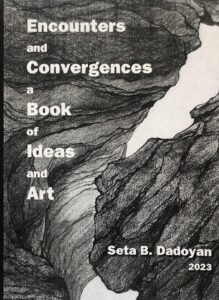
This article is the first in a four-part series on the making of Encounters and Convergences: A Book of Ideas and Art by Seta B. Dadoyan.
An amalgam of philosophy and art, the opus is conceived and composed as an oeuvre. It is a statement about my scholarship and art, and the commonalities between them. My basic argument is that all meaningful writings and artworks are essentially responses to circumstances. Understanding and reflecting human “situatedness” (in Heidegger’s term) are their motive and objective. Situatedness means the interconnectedness of perceptions, reactions, social-historical experiences and circumstances. It implies the social embeddedness of both literature and arts as contexts for encounters and convergences between writers, artists and their worlds. While encounters mean confrontations and dynamic relationships with everything, convergences are meetings and the generation of new “horizons” (in Gadamer’s term), where things come together both for the understanding and aesthetic enjoyment. Circumstances change and so do “horizons,” as new writings and artworks unfold new insights, and despite bleak foresights, possibilities of change seem to be more possible. The sensitivities of artists and intellectuals, as well as the depth of their understanding, vary, but their works always reflect their distance from and concern for these issues. In the end, the “truth-content” (in Adorno’s phrase) of the given work becomes the measure of its significance.
In the case of my scholarship and art, the effort to arrive at “horizons” for convergences has been existential, or directly related to the meaning of my existence. Understanding my social-historical situatedness, or my condition, has always been both a motive and a purpose. This condition, that I share with a great number of Armenians, is being a multilingual and multicultural Armenian native of the Near East, with immediate family and ancestors driven from the extreme West and the extreme East of the Armenian World. It means having multiple hyphenated identities and inheriting multiple legacies of ancient and modern civilizations, peoples and cultures, including my own. In the processes of acculturation, this Armenian condition also required an urgency to understand the Armenian historical experience in comprehensive and critical terms, and not through assumptions and semi-epic narratives. I was fortunate to have two tools for these processes—scholarship and art—and both meant engaging in discourses and debates within myself and with the different worlds and communities I was part of. Therefore, as I argue, both my scholarship and art required “being” historical and artistic in a personal and direct manner, and not just doing/talking history, philosophy and art by training and career. I wrote and painted at specific periods and in response to specific circumstances, and thus, the second part of the book is structured on a schematic autobiographical grid.
Opposed to conventional and so-called “strictly academic” or “strictly artistic” practices, the book is also an illustrated argument, of sorts, in favor of interdisciplinary approaches. Like several contemporary thinkers, I consider dichotomies between disciplines and strict specializations artificial and “schizophrenic,” as Fredric Jameson puts it. Furthermore, looking at the arts as separate and distinct areas and activities, and judging artworks based on random concepts, such as taste, enjoyment, pleasure, digression or idea, miss and distort their social, historical and intellectual dimensions. Also, evaluating the arts in terms of the artist’s conceptuality and institutional legitimation in an “artworld” (a term coined by Arthur Danto), unscrupulously overlooks the social-historical embeddedness of human civilization as well. Unfortunately, these approaches seem to have become dominant and contributed to the blooming and proliferation of “scandalous” works, as Hal Foster describes.
However, since the establishment of the Frankfurt School, for almost a century, in consideration of the arts, the humanities and the social sciences as tools for a critique of the world and the emancipation of humanity, many authors have urged awareness of the deterioration of contemporary mass cultures, media and their hegemonic aspects. Politics and the social sciences are deliberately kept at a distance from humanities and mass entertainment, observes Edward Said. Pointing at the absurdity of the separation of fields and disciplines, he suggests that “instead of non-interference and specialization, there must be interference, crossing of borders and obstacles.”
Primarily as a critical, creative and not a descriptive or expository work, this “book of ideas and art” is written with these concerns. The objective is to communicate in words and images encounters and convergences with challenges and contradictions at different phases of my life. It is therefore self-reflective in conception, cross-disciplinary in scope, dialectical in method, hermeneutical in approach and in this case, artistic in expression. It consists of 175 large pages and 94 images. The contents are as follows:
- The ‘Prologue on Scholarship and the Arts’ introduces the subject.
- Part One, ‘My Aesthetic’, in five chapters, provides the theoretical-critical context by brief discussions of aesthetic issues and theories through art history and the contemporary situation of the arts and mass cultures.
- Part Two, ‘The Quest and the Path’, in four chapters, traces my path from the beginning, then to art schools, to my art of wartime (in Lebanon) and finally ‘Of the spirit of matter’ during the past two years.
- The ‘Epilogue’ concludes the book, culminating with an Appendix, ‘Content with List of Illustrations.’
Part One. My Aesthetic
- Aesthetics, Modernity, Postmodernism
- Cognitivism, Expressivism, Truth-Content
III. Social-Historical Embeddedness of Art
- The “culture industry”
- Concretization as Alternative ‒ The Artwork
Plato and Aristotle were the first to reflect systematically upon the arts. Since then, art has been defined as imitation, madness, catharsis, beauty, taste, judgment, pleasure, understanding, play, expression of emotion, psychological needs, spirituality and insight. Since different concerns and values are channeled through the arts, most definitions are bound to be too wide, too narrow or too dogmatic. The ontological status of art, or the question “what is art,” is the most basic yet controversial issue in aesthetics, a branch of philosophical sciences and part of the humanities. Coined in the 18th century after the Greek word aesthetikos, or sensory perception, aesthetics is the “science of perception.” It is also called philosophy of art ‒ perhaps not too accurately ‒ because artworks are also objects of knowledge.
Understanding my social-historical situatedness, or my condition, has always been both a motive and a purpose. This condition, that I share with a great number of Armenians, is being a multilingual and multicultural Armenian native of the Near East, with immediate family and ancestors driven from the extreme West and the extreme East of the Armenian World. It means having multiple hyphenated identities and inheriting multiple legacies of ancient and modern civilizations, peoples and cultures, including my own.
The tradition of Western art is usually traced back to Classical Greece and Rome. In the Middle Ages and under Christianity, the Classical forms and the ideals of pagan cultures receded. In the West, Christianity produced the sublime Gothic arts. In the East, under Islam, unique, geometric forms and patterns appeared in all the arts, and a different aesthetic and spirituality came about. Established traditions and criteria of art and beauty, especially in painting, were challenged in the 19th century by the romantics, the realists and soon the impressionists and the post-impressionists. Already in the early 20th century, tradition was challenged, improved upon, contradicted and sometimes almost abandoned by post-impressionism, cubism, surrealism, dada, ready-made art, experimental art, absurdist and generally avant-garde trends. On the other hand, there were fusions and overlapping, which generated unprecedented art forms everywhere.
I will skip the discussion about the historical development of art here and stop briefly at the concept of modernity and the truth-content of artworks. The term modernity was coined in the early 17th century. It comes from the late Latin adjective modernus, a derivation from the adverb modo, which means presently, right now. It referred to the achievements of the Renaissance, when Classical values and criteria were adopted and surpassed. Eventually, modernity was absorbed and exhausted; it was “dominant but dead,” as Jurgen Habermas put it. Highly controversial works for their times became classics and museum pieces. For almost a century, there has been a new “artworld.” It has its art-markets, where art is investment and artworks are often evaluated by their resale value. These factors seem to have distracted the critics and the public from core issues related to art, mass culture, entertainment and media. Postmodernism was a return to a serious reconsideration of tradition. It produced new and interdisciplinary approaches in social sciences and the humanities. Many contemporary figures like Michel Foucault are simultaneously philosophers, historians, psychologists and art critics.
Adorno’s concept of truth-content of artworks is closely associated with the concept of modernity. Édouard Manet (1832-1883) is often considered as the first “modern” artist to break with tradition, and the forerunner of Modern Art. However, I suggest that a closer look at the middle decades of the 19th century will show the beginnings of true modernity in the works and writings of Gustave Courbet (1819-1887), a contemporary of Manet, Karl Marx, Dostoevsky and Tolstoy. As a true humanist and modernist, he not only contradicted aesthetic traditions and revolutionized subject matter, but also captured the social-historical embeddedness of the arts, much more philosophically than the philosopher Marx. In an open letter, labeled as the “Realist Manifesto” (December 25, 1861, Paris), he wrote: “Each epoch must have its artists who express it and reproduce it for the future. The human spirit must always begin work afresh in the present, starting off from acquired results…The real artists are those who pick up their age exactly at the point to which it has been carried by preceding times…Beauty, like truth, is a thing which is relative to the time in which one lives and to the individual capable of understanding it.”
Some decades later, Leo Tolstoy (1828-1910) wrote: “Art is a human activity consisting in this, that one man consciously, by means of certain signs, hands onto others the feelings he has lived through, and that other people are infected by these feelings and experience them…If art is an important matter, a spiritual blessing, essential for all men (like religion, as the devotees of art are fond of saying), then it should be accessible to everyone. And if, as in our day, it is not accessible to all men, then one of two things: either art is not the vital matter it is represented to be, or that art which we call art is not the real thing.”
From Chapter II, “Cognitivism, Expressivism, and Truth-Content,” I will briefly refer to cognitivism. Clearly, in my aesthetic, the cognitive or the intellectual as well as the social aspects of the creative process and the truth-content of the artwork have primacy. Courbet and Tolstoy among others put them in extreme simplicity. In addition to other values, such as beauty, emotion and enjoyment, for aesthetic cognitivists artworks must have profundity of meaning, or a truth-content. Cognitivism does not cancel the other values and rewards that artworks provide, such as pleasure. Pleasure and cognition are not mutually exclusive; the arts enrich our understanding of experiences and give immense enjoyment. Susanne Langer (1895-1985), a cognitivist, suggests that since in the aesthetic experience the pleasure involved is more intellectual than sensual, then it is akin to the experience of discovering truth, hence the unique intellectual dimension and significance of art. Truth here does not mean correspondence to something outside the work of art, or a coherence with anything else than itself. Each artwork has its own truth-content by virtue of an internal dialectic between the artist, subject matter, content, form and other elements that come together in the creation of the work.
As discussed in Chapter III, “The Social Embeddedness of Art,” the first philosophical, rather cross-disciplinary, and comprehensive critique of culture, arts and society at large, came from the Institute for Social Research (established at the University of Frankfurt in 1923), known as the Frankfurt School. The scholars, known as critical theorists, studied cultural phenomena, such as music, film and mass entertainment. Focused upon human suffering and dedicated to universal emancipation, they suggested that social phenomena, such as culture, arts and mass entertainment, as well as other factors, play direct roles in maintaining and promoting domination and oppression. Their primary objective must be the emancipation of humanity from suffering and slavery and the creation of works that will lead to a world which satisfies the needs and powers of human beings.
Chapter IV is on the theory of “culture industry,” probably the most intriguing aspect of the thought of Theodore Adorno (1903-1969, one of the founders and prominent figures of Frankfurt School). Adorno depicts mass media in consumer societies as being based upon the systematic denial of genuine freedom. In consumer societies, the arts, especially music and performing arts, are parts of what he calls the “culture industry.” “Everything has value only in so far as it can be exchanged, not in so far as it is something of value in-itself.”
Mixed with mass media and entertainment, the arts are often instruments of homogenization.
The culture industry, according to Adorno, perpetuates rigid motifs that inhibit spiritual and mental freedoms and kill critical consciousness. With its emphasis on marketability, it deliberately and radically alters the core of the arts. Despite seeming and apparent liberalism and abolition of criteria and rules everywhere, there is massive standardization in all walks of life, which inevitably cancels intellectual stimulation. Artworks are treated as marketable commodities, accents and often screams. Their value becomes exchange value, and sometimes deliberately shock-value. The arts are totally controlled by the “culture industry,” art-markets, departments of fine arts, art schools, museums, journals and galleries. Mixed with mass media and entertainment, the arts are often instruments of homogenization. The public stands outside and anyway is a captive audience that often cannot even enjoy the artworks, because it cannot relate to or understand them. At any rate, understanding seems to have become a misplaced term in the artwork-viewer relationship. Fashion and pop arts are in turn examples of homogenization. At present, only gross exaggerations in attire, make-up, hair and mannerisms are distinguishing factors between individuals and works that otherwise are essentially indistinguishable.
Over a century ago, most artists of the absurd, Dada, readymade, avant-garde and related movements of the later decades, presented their works, and still do, on wings and cushions of certain philosophies of art. They are now assimilated into the fabric of consumer society, and as Habermas says, their modernism is now “dead.” One cannot talk in any seriousness on the aesthetic path drawn by works like Tracey Emin’s (1963-) “My bed” (an actual filthy bed), and thousands of similar works. Their message as well as their artistic legacy is limited and consumed in the initiatives. A no-boundary and subjective conceptualism cannot be sustained on just verbal wings. Deliberately artless and accidental forms and piles of objects, also sometimes intentionally made junk piled up or hung in galleries and museums, are now legacies of past times, even if they still have exchange value in addition to institutional and media support. The intellectual core in both the conceptual and artistic processes is lacking, and one wonders if an artwork can stand on an abstraction or a reification in the mind of the artist or an article in a national paper by an art-writer. The verbal appendices and footnotes may have a temporary role in the propaganda, but they are not part of the work, therefore aesthetically and in the long run irrelevant.
In Chapter V, “Concretization as Alternative ‒ The Artwork,” I propose what I call “concretization” as an alternative approach. In my aesthetic, and as mentioned, the social-historical embeddedness of art, dialectical thinking, culture industry, hermeneutical understanding, truth-content and situatedness are foundational elements. Based on these basic concepts, and to bypass – not to avoid, for that is an impossibility ‒ an abstract discussion on the ontology of art, I suggest a paradigm shift from focusing on the ontology of art, or “what art is,” to “what a given artwork means,” or its truth-content. This is a concretization or taking the artwork as a concrete and coherent entity, a thing-in-itself, which must carry its own truth-content and thus offer a journey worth taking. I argue that since the artwork is the only objective reality created in an art-language, in certain social-historical circumstances, also because of them, it is the only horizon or context and criterion for evaluation, understanding, communication and enjoyment.
Concretization is a shift from the artist to the artwork, which must contain a truth-content as the criterion of its aesthetic significance and value. A concept in the mind of the artist does not justify or legitimize an artwork. There is obviously an unscrupulous underestimation of the public’s taste and intelligence, when urinals, soiled diapers and scattered boulders are placed in museums and public spaces. Adorno writes: “The artwork has an internal truth content to the extent that the artwork’s import can be found internally and externally either true or false. This truth is not a construct, it is historical but not arbitrary; non-propositional yet calling for propositional claims to be made about it; utopian in its reach, yet firmly tied to specific societal conditions. Truth content is the way in which an artwork simultaneously challenges the way things are and suggests how things could be better, even if it may fail, as it will, to change anything.”
To sum up: the artwork is an “event,” an “actual occasion” (in A. N. Whitehead’s phrase) in which encounters happen with the things of the world and all converge in well-executed artistic forms. The truth-content is the totality of all the factors in the making of the work, be it a text, a painting, a musical composition or other. Furthermore, as a process, the work of art is a journey worth taking to encounter new knowledge and sensibilities. The more enriching these are, the more valuable the work is, but still the concrete object, the artwork, remains the core, the center.
Part Two. The Quest and The Path
- Prelude
- Paint and brush
- The cataclysm
- Museums, studios, models
- Encounters with Strife and Suffering
- Time of reckoning and choices
- First news and glimpses
- Wartime and situatedness
- Armenian painting in Lebanon
- The turning point – Aesthetic-philosophical positioning
III. Wartime Art and Aesthetic
- Moments and momentum of war
- “Landscapes”
- Thoughts and exits in chaos
- Exits to Armenia
- Portraits for the memory
- Of the spirit of matter
- My American-Armenian Experience – Re-positioning
- The transition
- From the “bridge” to “unconcealment”
Part Two in four chapters traces my path from the beginning to art schools in Beirut and London, then wartime art (1975-1991) and scholarship, then a second phase of scholarship over three decades, and finally back to art during the past two years. Two childhood dreams shaped my life and led me out of my hometown. The first was wearing what as a child I called the “square hat” (mortarboard), and the second was going to an art school. As a child, I don’t remember having toys or asking for any. I especially resented dolls, and still do. Since there was no shortage of reading material in the house and my immediate environment, I read whatever I found; I drew on any piece of paper, painted landscapes and portraits, and participated in local exhibits. My art education remained a pending matter while in my hometown Aleppo. Since the language of instruction at school was Arabic and French, I signed my name Séta. I have included a few of my early works, and one landscape of olive trees.

In 1965 I graduated from BCW (Beirut College for Women) with two majors: fine arts and philosophy. The dream of the “hat” came true, but studying art was a devastating encounter with the realities of art education at this college at that time. After graduation, when I began reading art history and aesthetics, I was appalled at the poverty of the entire fine arts curriculum. The encounter with a certain instructor was cataclysmic. Soon after graduation I destroyed everything that I had made, except for a plaster figurine of Socrates, “Socrates the Satire,” from a sculpture course, and “Broken face,” from a ceramics course. Socrates, the wisest man and greatest satirist, as Nietzsche described him, stood for my deep discontent and critical dispositions; the broken face was mine as a painter.
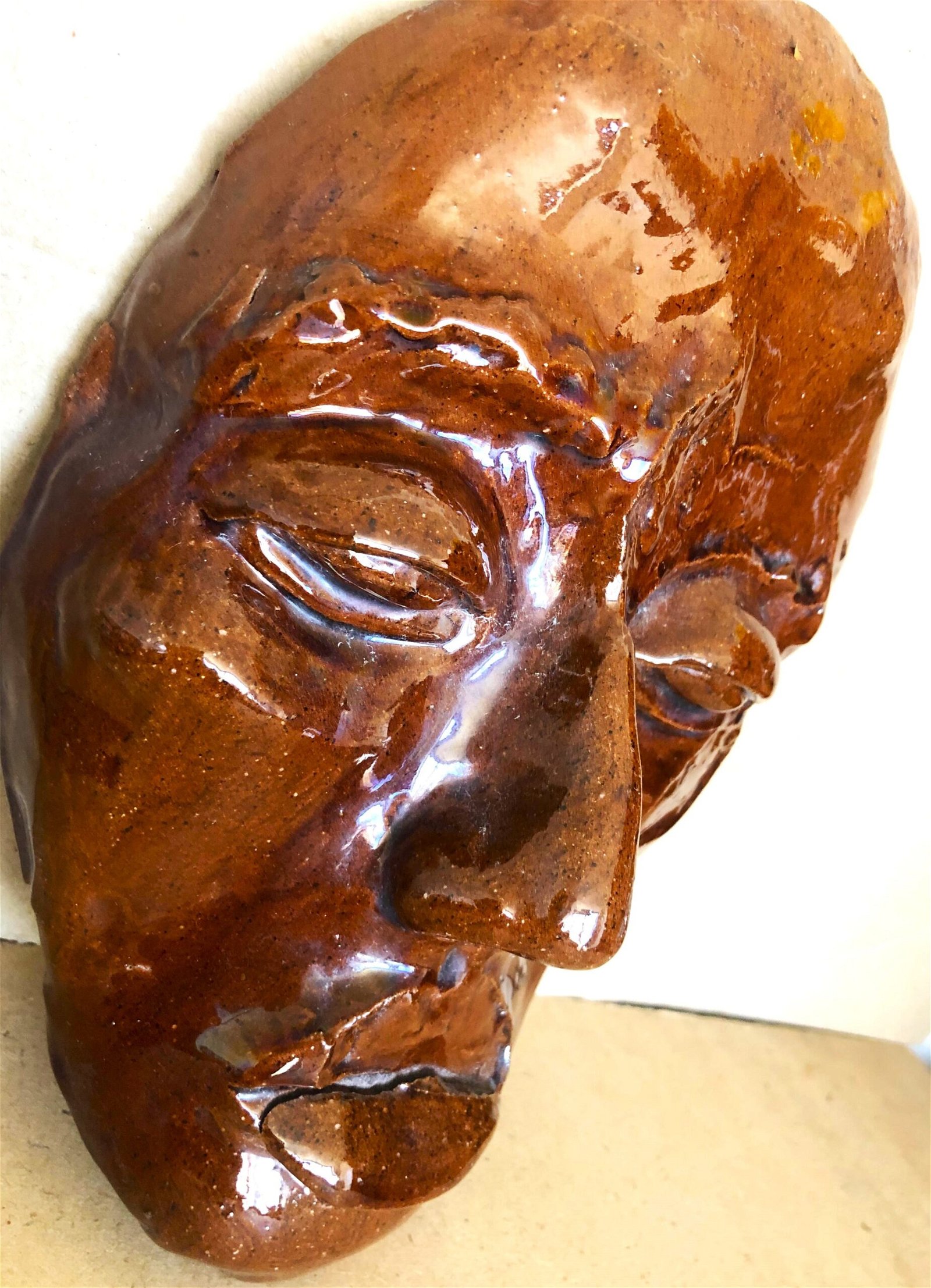
In 1966, I spent a year at the City and Guilds School of Arts in London, where I worked with great enthusiasm on figure drawing. In my spare time, I visited the museums and sketched. Of the dozens of sketches, I have included three: our backyard from the bedroom window and two models. A year in London set new standards and frameworks for my aesthetic; it also expanded my knowledge of art history, but I still failed to overcome the trauma at BCW. In 1967, I began graduate studies in philosophy at AUB (American University of Beirut) and graduated two years later with a dissertation in medieval Armenian philosophy. Previously, my thesis for the bachelor of arts degree had been in the same discipline.
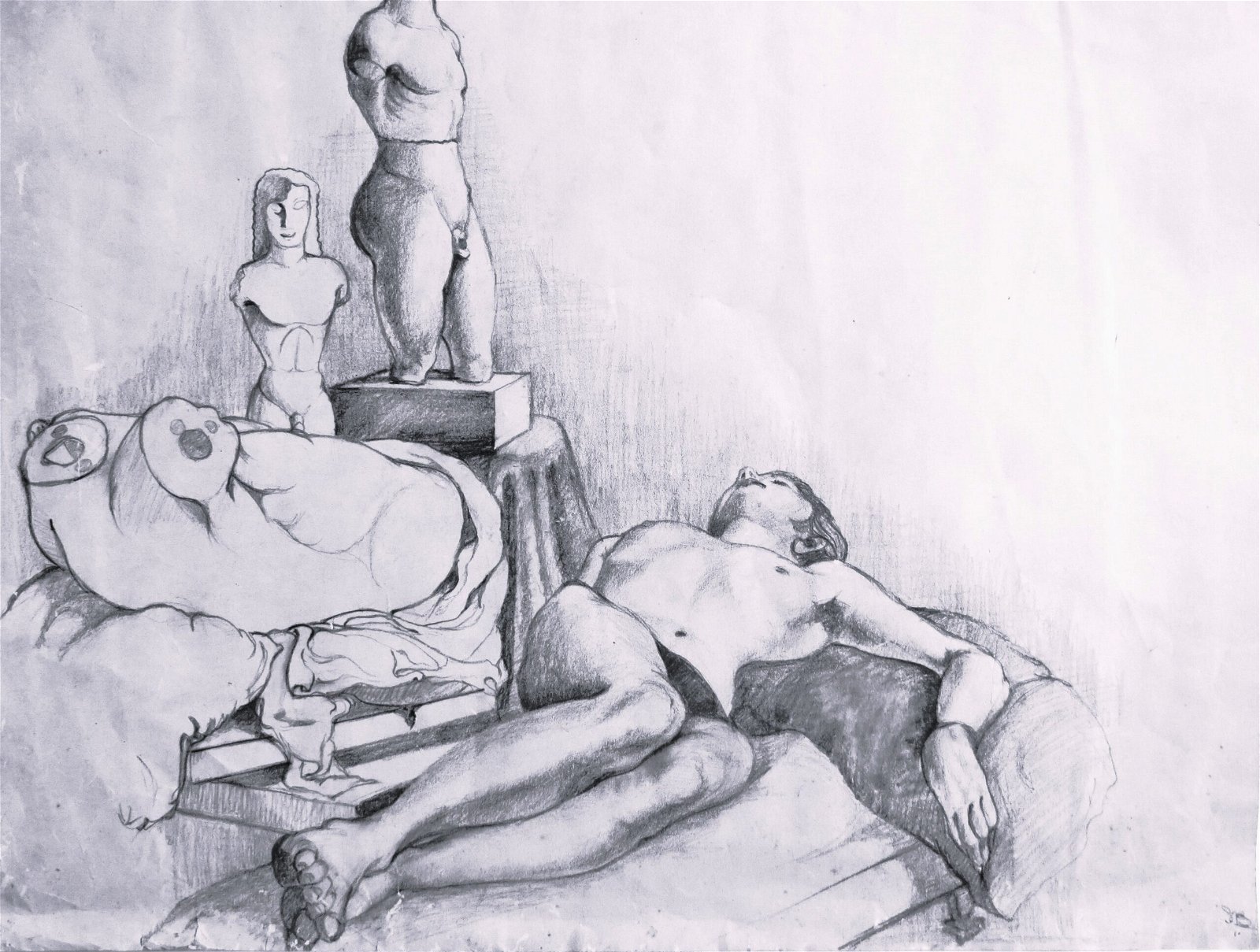
Medieval Armenian intellectual culture and its relations with the Islamic environment, a subject remotely approached in Armenian studies, intrigued me both as an Armenian native of the Muslim world and as a student of philosophy. In 1969, as a graduate student, I made a “discovery” that the little known treatise by Yovhannēs Erznkats‘i (d. 1292/3) entitled “Views Gathered from the Writings of Tajik [Muslim] Philosophers” (I Tachkats‘ Imastasirats‘ Grots‘ K‘agheal Bank‘) was in fact a beginner’s summary of the esoteric compendium of sciences, the Epistles of the Brethren of Purity (Rasā’il Ikhwān al-Ṣafā’) of the 10th century at ‘Abbāsid Basra. Soon, I found out that Yovhannēs had also borrowed and adopted an Islamic cosmological treatise, basic texts from the Nāșirī futuwwa (urban youth coalitions) literature, and the latter’s Constitution into Armenian culture and gone completely unnoticed. These were complete novelties both for Armenian and Islamic scholarship.
In philosophical hermeneutics, the hitherto unknown Islamic sources of a prominent Armenian theologian-philosopher of the 13th century is called “relevant information.” The paradigm created by the initiative of Yovhannēs shattered my horizon of things Armenian and what was done in Armenian Studies under narrow and partial themes such as “Arab domination in Armenia,” Armenian “colonies [gaghut] in the Arab world,” the “contribution of Armenians” and surely the Genocide. The case of Erznkats‘i opened a new vantage point on the vast and unexplored field of Islamic-Armenian interactive history, and generally, the Armenian historical experience in worlds of Islam. It was a beginning that would define much of my scholarship. In general, understanding 14 centuries of the historical experiences of the Armenians with Arabs, Turks, Mongols, Kurds, Iranians and Indians had existential significance for me. I grew up in a mixed part of the old city of Aleppo, where historic churches and mosques stood side by side. As a trilingual child (speaking Armenian in the family, Arabic with neighbors and school and Turkish with grandparents) growing up in a very nationalist Dashnak environment, I felt as a native but of a certain peculiar category. At the university in Beirut, where in the sixties dozens of nationalities and cultures from the East and the West mingled in this cosmopolitan city, identity was an elastic issue but no great concern, at least theoretically. As I saw it then, beyond essentialist assumptions and nationalist models, both as concept and perception, identity was not an apeiron or undefinable something, but an awareness that various interactions and experiences simultaneously generated and absorbed.
Chapter II, Encounters with strife and suffering ‒ In 1975, the start of the war in Lebanon, my return to art was a spontaneous response to the first news of the war. At the time, we were in Kettering-Dayton, Ohio. I did most of my meditating and drawing on the ominous situation, sitting on the couch by the terrace door. This was my “view.” I tried to process my encounters with the catastrophe. In the book I have included four sketches, one of which is pictured here.
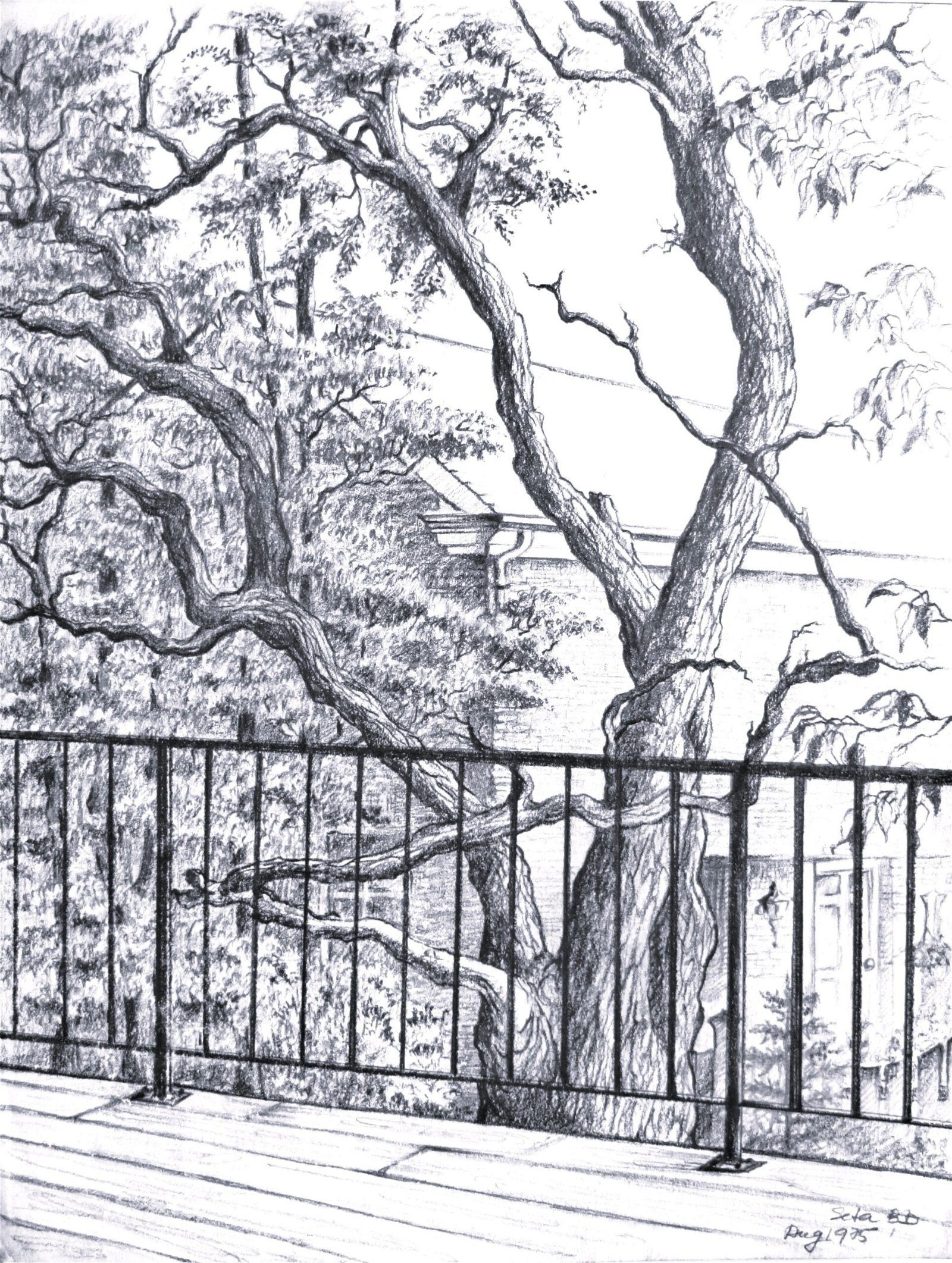
From the spring of 1975 to the summer of 1991, war was the universe. Between episodes of calm, random or deliberate bombardment, sniper fire, assassinations, kidnappings, street battles, stray bullets and shrapnel, also in the house were wartime realities. Life continued despite the war-circumstances, which should have put things at a standstill. In most arts, especially music, theater and literature, brilliant artists drew revolutionary paths. There were brave intellectuals, journalists, poets, painters, sculptors and theater people. Some were liquidated; others forced to migrate. Encounters with music, theater and literature were intervals or “intermezzos” for us. I have one, from Caracalla’s dance theater, “Intermezzos at Caracalla.”
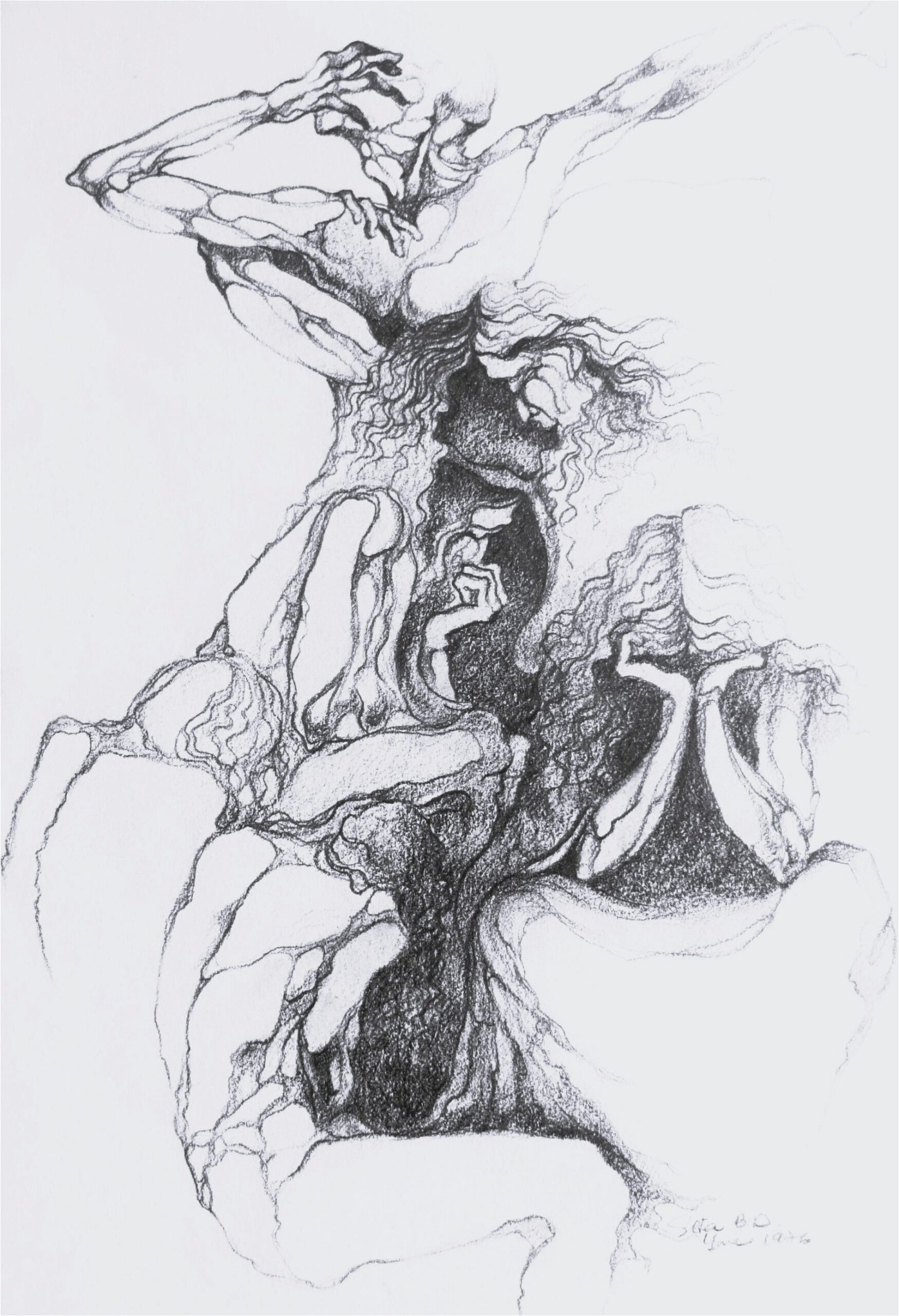
My first encounter with death was in the early summer of 1976. It was a sniper victim at our building door on ‘Abd al-‘Azīz street in Hamra. I made a sketch immediately, “Sniper fire.”

Hundreds of absurd deaths happened daily, everywhere and over the next 15 years. Ink pens, drawing pencils and sketch pads were portable media and always accessible. Dead people on the streets were iconic war-realities. During a relatively long period of calm in 1977, a feeble gleam of hope allowed me to return to the large canvas, and I made a mural-style painting in acrylic as a tribute to all those who struggled, endured their condition in pain or died, “Mural in tribute.”

During the next few years, and prior to what I call my “wartime” drawings, also as a form of self-placement and self-identification, I began an ambitious project of writing the history of Armenian painting in Lebanon, the most intriguing aspect of the community in Lebanon at the time. Now as a “Lebanese-Armenian” (from Syrian-Armenian), also an intellectual and painter, I wanted to define my own position and path in the context of Lebanese-Armenian culture. This was a Nietzschean reversal of the Cartesian cogito. Instead of ‘Cogito ergo sum’—I think therefore I am—it was a moment for ‘Sum ergo cogito’—I exist, therefore I think—rather, must think.
From the early sixties to the mid-seventies, Lebanon was at the height of a revival of sorts. Many factors in the making and the historical development of this extraordinary country at that period contributed to turning it and the people (of over 15 different ethnic and religious factions) into bridges between the West and the East. Yearly, a few hundred art exhibitions and “salons” were held. Strangely, most Lebanese painters were Armenian. This was an intriguing phenomenon that needed explanation and historicization. It became the problematique of my research. The phenomenon was unusual for several reasons. The most important was the fact that the art of painting – not miniatures, decorative arts and crafts ‒ was not an art that Armenian survivors from the 19th century Ottoman massacres and the Genocide in 1915 brought with them to the Arab countries. There was no art of painting of any type and standard in Cilicia and the Armenian provinces of Turkey, where hundreds of thousands were either eliminated or driven out. I argued that if practically, the art of painting among Armenians first appeared in Syria, Lebanon, Egypt and some of Europe, then the phenomenon had to do with local circumstances. Therefore, painting was an expression of the responses of the artists to their condition, hence the social embeddedness of their work and its unique historical significance. Furthermore, I believed that painting, music and dance flourished, because they bypassed the linguistic barrier and other economic and social challenges that most Armenians faced during those decades. Therefore, my basic argument was that the post-Genocide Armenian condition in Lebanon was the soil out of which the art of the Armenian painters grew and reflected it.
On these grounds I began my research into the history of Armenian painting in Lebanon, focusing on about 50 figures who were active from 1930 to 1980. Locating and collecting basic information about the painters, their works, exhibitions and other artistic events were initial tasks. There were no references or studies of any sort about the art of the Armenians or the community in Lebanon, except casual reports in the papers. Literally, I had to go through the entire press of half a century, visit the galleries, interview the painters themselves, as well as individuals who were close to painters’ circles and collectors. I gathered photographs, advertisements, posters, brochures and tickets. In the meantime, I also took photographs of all the paintings and the artists I came across. When fieldwork was too dangerous, I went back to my research and writing on other subjects.
My research confirmed my initial hypothesis that the works of the painters were indeed responses to the post-Genocide Lebanese-Armenian (Libananahay) circumstances and had to be analyzed as such. Style was secondary and followed other factors. Therefore, classifications could not be based on stylistic aspects nor strict chronology. I identified six types of responses to the crisis of identity and organized my analysis and the book accordingly: a passive reaction to the local conditions and a withdrawal into the tragic past and a sub-reality; a positive reaction to the special circumstances of the Armenian community and a humanistic art, which however was too abstract and formalistic; formalism and a strongly academic disposition; a negative reaction, rejection and surrealism; a positive neutralism and a stylistic preoccupation; a direct adoption of local identity and marginalization of national identity. The book was supposed to be published within the same year, but it was delayed by three years because of the ongoing war. It is entitled Armenian Painting in Lebanon in the Light of the Crisis of Identity [Լիբանանահայ Նկարչութիւնը Ինքնութեան Տագնապին Լոյսին տակ], 1984.
If the measure of the meaning of a work is its truth-content, then its focus must be on the realities of life at the given time. This is what I mean by my aesthetic-philosophical positioning. My aesthetic took a sharp turn from studio mentality into wartime mentality, to the facts of universal suffering. As their titles suggest, all my sketches until the end of the war are based on specific events, situations, persons, responses and thoughts. I was at a turning point with a cathartic force that produced a sketch, “End of the studio.”
I had to re-position myself also as a West Armenian thinker. Already in 1982, I began reading whatever was available on West Armenian philosophical thought from the 19th century onwards. I focused on five major figures and identified two distinct trends: the transcendentalists and the vitalists. I also made their portraits and annexed a philosophical glossary in Western Armenian. The book was published in 1987, entitled Pages of West Armenian Philosophical Thought [Էջեր Արևմտահայ Մտածումէն].
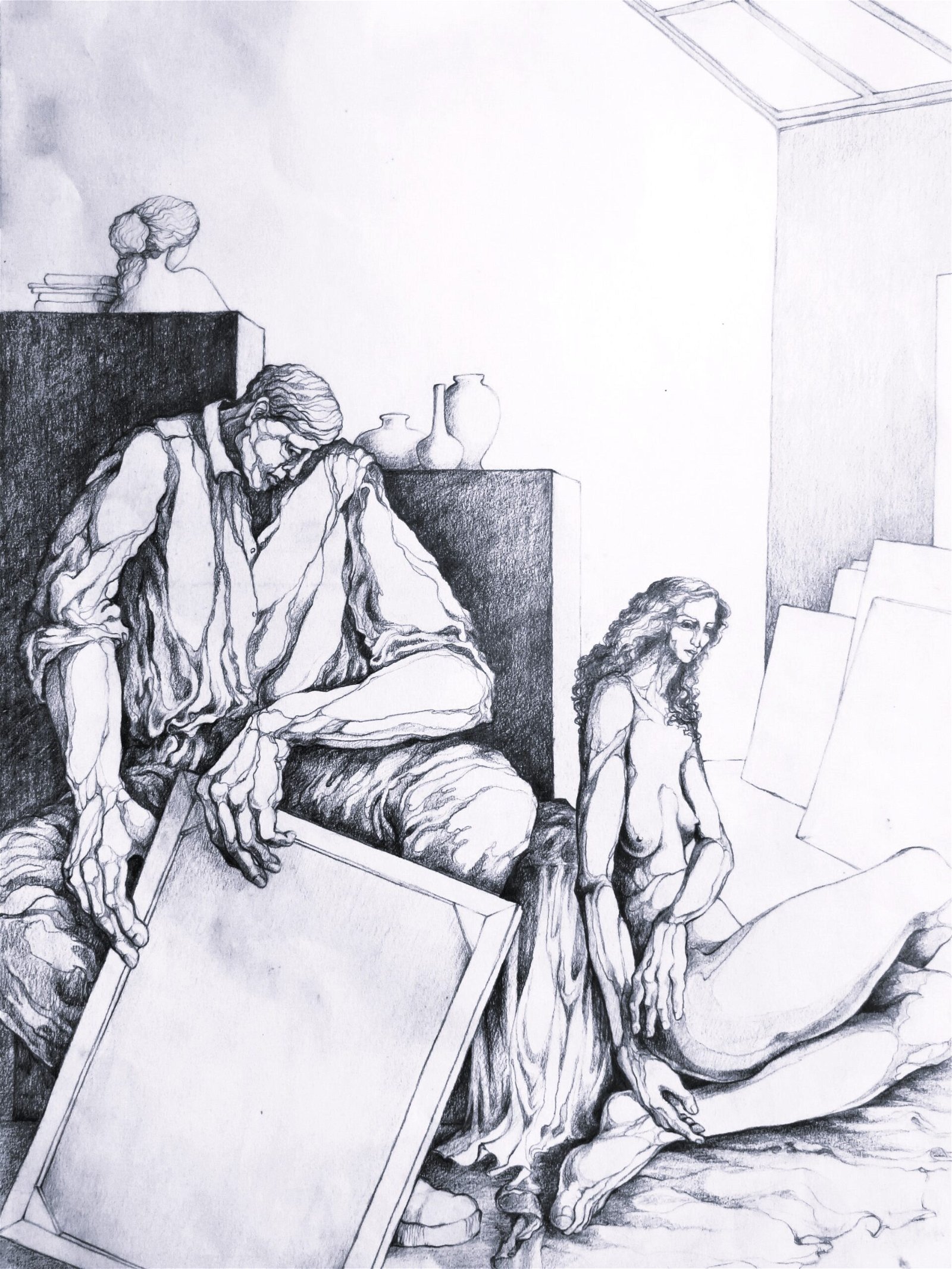


Be the first to comment